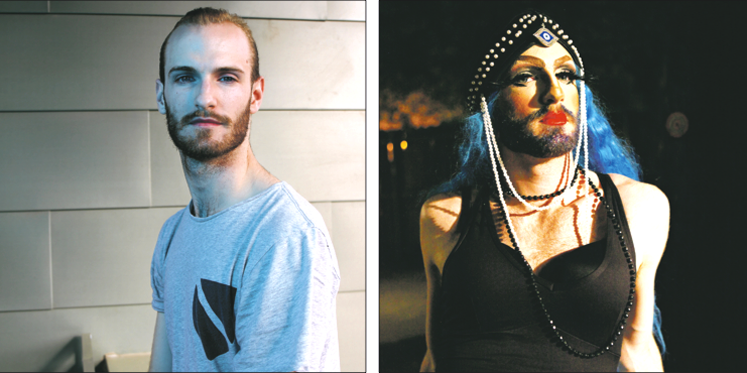The first time dance senior Kelsey Rondeau put on a pair of stilettos and transformed into Kalandra Bankhead, he was a 19-year-old freshman.
Donning a sparkling gold and brown floor-length dress and a red wig, the glitzy Kalandra Bankhead made her debut lip-syncing to Florence + the Machine’s “Shake it Out” for the Queer People of Color & Allies Drag Ball in the SAC Auditorium.
“I just got out on stage and jumped around,” Rondeau said. “I had the time of my life. It was a moment where I realized I wanted to turn this into something.”
Since then, Kalandra Bankhead has become what Rondeau describes as an extension of himself. As he speaks, he can seamlessly transition between each persona without skipping a beat.
“Kalandra Bankhead was born in her family’s summer trailer home in East Hampton, N.Y.,” Rondeau said. “After dropping out of the Sister Mary Ignatius School of Gratuitous Glitter, she hitchhiked her way to Austin, Texas, searching for stiletto heels that will fit her water ski feet.”
Rondeau said a lot of the time, Kalandra Bankhead just makes it up as she goes along.
“With Kalandra, she is a character I can slip into and out of,” Rondeau said. “Kalandra is a very exaggerated version of me. She’s cruder, she’s louder but she’s even more fabulous.”
While he was able to solidify his interest by watching shows such as “RuPaul’s Drag Race,” Rondeau can’t recall exactly when he first dressed in drag.
“I would play dress-up with my sister as a kid, so I kind of considered that to be ‘baby drag,’” Rondeau said. “I never considered it to be a conscious thought — like, ‘I’m going to create this character’ — until I was 19. I met a couple of drag queens downtown and then I decided I really wanted to do this.”
Rondeau is one of the founding members of Queens of Texas, the first and only student group dedicated to drag performance, history and technique. Members of Queens of Texas, whom Rondeau fondly calls “the girls” or “drag daughters,” meet every Wednesday to talk about previous and upcoming shows, shop for supplies and check in on each other’s progress.
“Drag, for the most part, is such a solitary thing,” Rondeau said. “I wanted to create a collaborative, supportive environment where everyone can come together and get help for what they need to hone their craft and become better performers.”
Philip Karjeker, an art history senior, has been friends with Rondeau for almost four years. He said they are a part of the same “drag family.” Karjeker said that beyond the performance aspect, Queens of Texas is focused on encouraging open discussion about gender, sexuality and culture.
“For drag queens, especially for Kelsey, who performs with a beard — you know, what do you say?” Karjeker said. “For a lot of people, when you go to drag shows it’s almost an unconscious switch to refer to drag queens as ‘she.’ It’s really this confusion of what gender and sexuality mean.”
Both Karjeker and Rondeau explained that drag is, in its most basic notion, a chance to embody and be comfortable within a different persona.
“Drag is everywhere, drag is everything,” Rondeau said. “I go out on stage with a glitter beard and a hairy chest, and I celebrate the fact that I am a male. I also exaggerate femininity. I am both and neither at the same time. What I want to do is kind of shatter what people’s thoughts and expectations are of gender.”
When Kalandra Bankhead takes the stage, she is typically wearing sky-high heels and strutting to power ballads like Chaka Khan’s “I’m Every Woman,” with her glittery beard on full display. The audience dances along with her, with some people handing her dollar bills as she spins past them.
While performances are filled with support, the world outside of shows isn’t always so understanding.
“I still face kind of a backlash,” Rondeau said. “Really, anyone in the gay community who displays femininity faces some sort of backlash.”
Rondeau is currently a part of the UT Lab Theater series titled “Being/with others,” which is a collaborative performance. Lucy Kerr, a theatre and dance and philosophy senior and the director of “Being/with others,” said that Rondeau’s solo is focused on his relationship to drag and the stigma surrounding gay male femininity.
“His performance deconstructs the vulnerabilities of being a drag artist,” Kerr said. “It’s a part of his life and who he is. Because drag is so presentational, so confident, so outward, but this performance reveals the vulnerabilities behind that.”
For Rondeau, drag is personal.
“I don’t do this for you,” Rondeau said. “This is for me. I identify as male, but my gender is kind of fluid. You can’t make assumptions based on somebody’s outward appearance. Don’t presume to know.”
Within a constantly evolving discussion surrounding gender and sexuality and in the drag world at large, Rondeau said the important thing is to be original.
“Drag is one of the most liberating things you can do for yourself,” Rondeau said. “To explore a different part of you that you might not get to express is so liberating.”





















